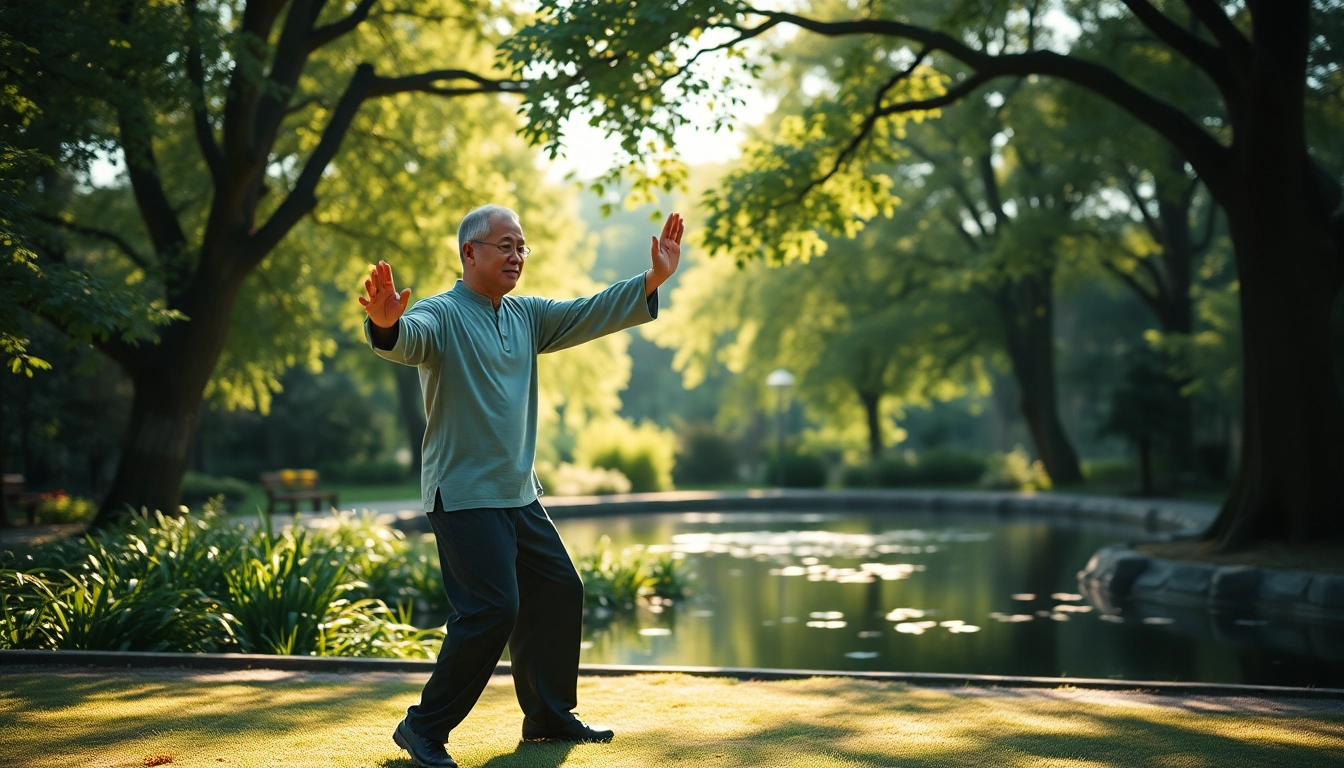
Understanding Tai Chi: An Introduction for Beginners
What is Tai Chi?
Tai Chi, or Tai Chi Chuan, is a martial art known for its slow, graceful movements and meditative postures. Originating from ancient China, it is often described as “meditation in motion” and is practiced for various reasons, including physical health, mental well-being, and self-defense. As a low-impact workout, Tai Chi is accessible to individuals of all ages and fitness levels, making it an excellent choice for beginners. The practice emphasizes balance, flexibility, and a mind-body connection, which are essential for fostering a holistic approach to health.
History and Origins of Tai Chi
The history of Tai Chi dates back to the 13th century, with roots in the Chinese martial arts and philosophy, particularly influenced by Taoism. Legends tell of Chen Wangting, a 16th-century royal guard of Chen village, who combined his martial arts training with traditional Chinese medicine to develop an art form focusing on flowing movements and energy cultivation. Over the centuries, various styles of Tai Chi have emerged, including Yang, Chen, Wu, and Sun, each with unique characteristics yet maintaining the core principles rooted in Tai Chi’s history.
Benefits of Practicing Tai Chi for Beginners
Practicing Tai Chi offers numerous benefits that can enhance both physical and mental health. For beginners, it provides a gentle introduction to exercise while yielding significant advantages:
- Improved Balance and Coordination: Tai Chi movements promote stability and coordination, which can prevent falls and enhance overall body awareness.
- Stress Reduction: The meditative nature of Tai Chi helps in relieving stress and anxiety, aiding mental clarity and emotional balance.
- Enhanced Flexibility: Regular practice can improve joint flexibility and muscle elasticity, increasing mobility and reducing stiffness.
- Strength Building: Although Tai Chi appears gentle, it involves controlled movements that can strengthen muscles over time, enhancing overall fitness.
- Cardiovascular Health: Studies suggest that Tai Chi can improve heart health and circulation while lowering blood pressure.
- Boosted Immune Function: Engaging regularly in Tai Chi practices may enhance the immune system, contributing to overall well-being.
Getting Started: Essentials for Beginners in Tai Chi
Key Principles of Step-by-Step Tai Chi for Beginners
When starting your journey in Tai Chi, understanding the key principles is vital for effective practice:
- Slow and Relaxed Movements: Tai Chi emphasizes fluid movements that should be performed slowly and deliberately, allowing practitioners to focus on posture and breathing.
- Mindfulness: A critical aspect of Tai Chi is being present in the moment, harmonizing the mind and body to create a meditative experience.
- Posture and Alignment: Proper body alignment is essential. Beginners should focus on keeping their bodies relaxed and aligned throughout movements.
- Breath Control: Deep breathing is integral to Tai Chi practice, supporting relaxation and enhancing energy flow (Qi) throughout the body.
- Energy Flow: The concept of Qi emphasizes the importance of energy circulation; Tai Chi helps to cultivate and balance this internal energy.
Required Gear and Attire for Practice
Getting started with Tai Chi doesn’t require an extensive wardrobe, making it an accessible practice for anyone. However, wearing the right attire can enhance your experience:
- Comfortable Clothing: Opt for loose, breathable fabrics that allow for unrestricted movement. Many practitioners choose traditional Kung Fu attire, although any comfortable sportswear will suffice.
- Footwear: Tai Chi is typically practiced barefoot or with lightweight shoes that provide traction without being too restrictive. Avoid shoes with a thick sole, which may hinder movement.
- Accessories: While not mandatory, some practitioners use a Tai Chi fan or sword to practice forms and perfect their techniques.
Finding the Right Learning Resources
To effectively embark on your Tai Chi journey, finding resources tailored to beginners is crucial. Here are some tips:
- Join Classes: Look for local Tai Chi classes or workshops through community centers, gyms, or martial arts studios. Having an instructor to guide you can be invaluable.
- Online Tutorials: Various online platforms offer step-by-step Tai Chi for beginners videos and tutorials that allow you to learn at your own pace.
- Books and eBooks: A wide range of literature is available that details the philosophy, history, and movements of Tai Chi, helping deepen your understanding.
- Mobile Apps: Consider apps dedicated to Tai Chi that feature guided sessions, instructional videos, and tracking progress.
Step-by-Step Tai Chi Movements for Beginners
Basic Tai Chi Postures and Their Importance
Before diving into specific movements, it’s essential to familiarize yourself with the basic Tai Chi postures. These foundational stances serve as the building blocks for more complex movements:
- Wu Chi: The basic stance of Tai Chi, where practitioners stand relaxed with feet shoulder-width apart, emphasizing balance and stability.
- Parting the Wild Horse’s Mane: This posture involves stepping forward while performing a sweeping movement with your arms, symbolizing fluidity and grace.
- Brush Knee and Push: This movement combines knee bending with a sweeping arm motion, promoting coordination and balance.
- Embrace the Tiger and Return to the Mountain: A dynamic posture involving twisting the body while maintaining balance and focus.
These postures not only help in grounding your practice but also set the foundation for fluid transitions between movements.
How to Master the First Few Movements
As a beginner, mastering the initial Tai Chi movements is crucial for building confidence and a solid foundation. Here’s a simple step-by-step guide to help you:
- Start with Wu Chi: Stand in a Wu Chi stance, allowing your body to relax. Focus on your breath, inhaling deeply through the nose and exhaling through the mouth.
- Parting the Wild Horse’s Mane: From the Wu Chi stance, step forward with your left foot while bringing your right arm up and across your body to the left. Visualize sweeping aside obstacles as you extend your arms.
- Brush Knee and Push: Shift your weight onto your left foot, bringing your right foot back in a semi-circle. Extend your right hand forward while brushing your left knee with your left hand, then push forward.
- Embrace the Tiger: From your previous posture, pivot on your right foot, turn your body 90 degrees to the right, and embrace the imaginary tiger by drawing your arms in and bringing them back to your sides.
Practice each movement slowly, allowing your body and mind to synchronize. Aim to repeat the sequence, gradually increasing fluidity and confidence.
Creating a Consistent Practice Routine
Establishing a consistent Tai Chi practice routine is vital for progress and mastery. Here’s how to effectively create a routine:
- Set Aside a Regular Time: Choose specific days and times for your practice to create consistency. Morning is often regarded as the best time for Tai Chi.
- Start with Short Sessions: Initially, practice for 10-15 minutes a day, focusing on quality over quantity. Gradually extend your sessions as you build confidence and stamina.
- Incorporate Variety: Include a mix of basic movements, breathing exercises, and mindfulness practices to keep sessions engaging.
- Stay Flexible: Adapt your routine as necessary to accommodate other commitments, but aim to practice regularly.
- Track Your Progress: Keep a journal where you log your practice, noting improvements, obstacles, and reflections to encourage continued growth.
Common Challenges Faced by Beginners in Tai Chi
Overcoming Physical Limitations
Physical limitations can be a concern for many beginners, especially if they are not used to regular physical activity. Here’s how to approach these challenges:
- Consult a Healthcare Professional: If you have underlying health issues, consult your doctor before starting Tai Chi to ensure it’s safe for you.
- Modify Movements: Don’t hesitate to modify movements to suit your comfort level. For instance, perform standing postures while holding on to a wall or chair for support.
- Focus on Breath and Relaxation: Concentrate on your breath during practice. Breathing helps to reduce tension and allows you to ease into movements without strain.
- Gradual Progression: Take your time and progress at a pace that feels comfortable. Small, incremental improvements build confidence.
Staying Motivated During Training
Maintaining motivation during Tai Chi practice can sometimes be challenging. Here are strategies to keep you engaged:
- Join a Group: Practicing with others can provide a sense of community and encouragement, making it easier to remain committed.
- Set Achievable Goals: Create short-term and long-term goals to measure your progress. Celebrate milestones to acknowledge your commitment.
- Education and Learning: Continuously learn about Tai Chi, including its philosophy and advanced techniques, to develop a deeper appreciation for your practice.
- Mix It Up: Incorporate different Tai Chi forms, breathing exercises, and meditation to keep your practice fresh and stimulating.
Understanding and Correcting Common Mistakes
As a beginner, it’s normal to make mistakes while practicing Tai Chi. Recognizing and correcting these errors can enhance your training:
- Posture Awareness: Many beginners tend to lose awareness of their posture. Regularly check your alignment and adjust as necessary to maintain balance and stability.
- Breath Control: Inconsistent breathing can hinder your practice. Remind yourself to synchronize breath with movement, exhaling during transitions.
- Overexertion: Tai Chi should be gentle and fluid. Avoid tensing your muscles; instead, focus on relaxation and grace in your movements.
- Neglecting Practice: Regular practice is key. Schedule practice sessions to reinforce learning and make it a habit.
Advanced Tips for Enhancing Your Tai Chi Journey
Integrating Breathing Techniques in Step-by-Step Tai Chi for Beginners
Breathing techniques are fundamental to Tai Chi practice, helping practitioners cultivate focus, relaxation, and energy flow. Here’s how to integrate breathing into your practice:
- Diaphragmatic Breathing: Practice deep breathing by allowing your abdomen to expand on the inhale and contract on the exhale, promoting relaxation and oxygen flow.
- Synchronize Breath with Movement: Inhale during upward movements and exhale during downward transitions to maintain a natural rhythm.
- Visualization: Use visualization techniques while breathing to imagine energy flowing through your body, enhancing the mind-body connection.
- Mindfulness Practices: Incorporate mindfulness meditation focused on the breath to prepare your mind for Tai Chi practice and to enhance concentration.
Exploring Tai Chi Forms and Styles
Beyond basic postures, Tai Chi encompasses various forms and styles, each with its unique flavor and approach. As you become more comfortable, consider exploring:
- Yang Style: Known for its gentle, flowing movements, Yang Style is popular for its accessibility to beginners.
- Chen Style: This style incorporates more explosive movements and is considered the original form of Tai Chi, offering a blend of strength and grace.
- Wu Style: Characterized by its small frame and fluidity, Wu Style focuses on rooted stances and subtle movements.
- Sun Style: Combines elements of Tai Chi with Tai Chi’s accompanying martial arts, integrating agile, lively movements.
By exploring various styles and forms, practitioners can find what resonates most with them, contributing to personal growth and a richer Tai Chi experience.
Connecting with the Tai Chi Community for Support
Finally, engaging with the Tai Chi community can significantly enhance your learning and motivation:
- Attend Workshops and Seminars: Participating in local or national Tai Chi events provides opportunities to learn from experienced instructors and connect with fellow practitioners.
- Online Forums and Groups: Join online Tai Chi communities to share experiences, ask questions, and find support from others who are also on the learning journey.
- Social Media: Follow Tai Chi influencers and educators on platforms like Instagram or YouTube for tips, tricks, and inspiration to enhance your practice.
- Buddy System: Find a practice partner to train with regularly. This can create accountability and provide motivation to stick with your practice.







